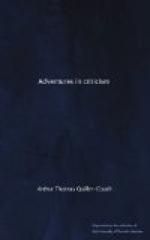If one thing more than another convinces me that Mrs. Woods has thoroughly realized these queer characters of hers, it is that she makes them so much like other people. Whatever our profession may be, we are generally silent upon the instincts that led us to adopt it—unless, indeed, we happen to be writers and make a living out of self-analysis. So these strollers are silent upon the attractiveness of their calling. But they crave as openly as any of us for distinction, and they worship “respectability” as heartily and outspokenly as any of the country-folk for whose amusement they tumble and pull faces. It is no small merit in this book that it reveals how much and yet how very little divides the performers in the ring from the audience in the sixpenny seats. I wish I had space to quote a particularly fine passage—you will find it on pp. 72-74—in which Mrs. Woods describes the progress of these motley characters through Midland lanes on a fresh spring morning; the shambling white horses with their red collars, the painted vans, the cages “where bears paced uneasily and strange birds thrust uncouth heads out into the sunshine,” the two elephants and the camel padding through the dust and brushing the dew off English hedges, the hermetically sealed omnibus in which the artistes bumped and dozed, while the wardrobe-woman, Mrs. Thompson, held forth undeterred on “those advantages of birth, house-rent, and furniture, which made her discomforts of real importance, whatever those of the other ladies in the show might be.”




